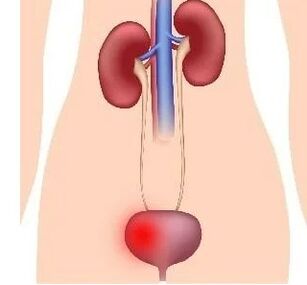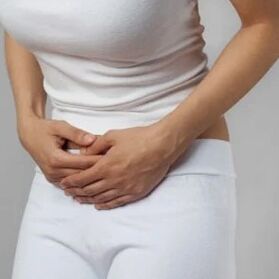Cystitis- This pathology, characterized by the development of inflammatory process that affects the bladder wall as a result of the effects of bacterial microorganisms.

Statistical cystitis- One of the most common urological pathology. Women are predisposed to much more on the appearance of this inflammation, because of their morphofiziological characteristics.
Bacterial agents entering into the bladder cavity are possible in three ways:
- Ascent- Through the urethra (urethra). The main role in this version of the penetration of microorganisms belongs to the anatomical and morphological characteristics of the female tract: a short and wide urethra, closely arranged with anus and vagina.
- Down the path- From the kidney. This option is developing as a codes of renal inflammation, for example, chronic pyelonephritis.
- Hematogenic track- The schedule option is established when cystitis appear immediately after infectious diseases or when another source of gnody infection in the women's body is detected. There is also the probability of bacterial microflora in the bladder due to the presence of anatomical anastomosis (link) between the lymph vessels of the genital bodies and bladder, subject to striking changes in the above.
The most common causal agent of the inflammatory process of the bladder is E. coli (in 4 of 5 cases, which is associated with the above-mentioned anatomical and morphological characteristics and the presence of this microflore in the intestines).
Simple, cystitis is connected to staphylococcal, streptococcal and enterococcal microorganisms. Gram - Nephen sticks cause urinary bladder inflammation due to instrumental and surgical interventions.
Recently, the frequency of cystis is associated with fungal microorganisms, the simplest and viruses.
Only the introduction of infectious microorganisms is not enough to develop a complete inflammatory response to the bladder, because the body contains resistance mechanisms of pathogenic flora.
Citizens' development factors
So, in addition to the etiological factor, factors like:
- Hemodynamic function disorder(circulation of blood) pelvic authorities and, especially, bladder;
- Disorder excreted bladder function(Urine stagnation);
- Inhibition of different immune bodies(Vitamin deficiency, low temperature exposure, stress, increased fatigue, etc. );
- Passionate effects of biochemical meansand exchange products that are released in urine to the building of the bladder wall;
- Exposure to radiological rays;
- Non-compliance with hygieneExternal genital and random sexual intercourse;
- Pathology of gastrointestinal tract, in the presence that microflora accumulates and increases its activity, which subsequently enters the urinary tract;
- Regular shifts of hormonal metabolismwhich leads to a lack of tons of urethra and creates the best conditions for infection.

The first symptomatic events of cystitis in women
The acute cystitis clinic in a woman is characterized by a sudden beginning and expressed by a symptom complexWith:
- Frequency of Frequency (Pollakiuria)which characterizes the frequency at least once in 60 minutes and small amounts of released urine; With the development of frequent imperative urges, patients are unable to control and maintain urine;
- Dysuria (Violation Breach)followed in pain in the hypogastric region (in the lower abdomen). Development of inflammatory process in the bladder wall, these symptoms are progressing: the more developing, which is more often urinating and more intense pain;
- Itching in urinary roadsoccurs during the urination act. It develops due to the exposure to the mucosa of the microorganism of microorganisms of the microorganism of the microorganisms that caused the inflammation of the bladder;
- The appearance of drops of bloodAt the end of the Urine Law;
- The appearance of urine blur, due to intrusions of a large number of blood cells (leukocytes and red blood cells), bacterial microflore, surface epithelia of the internal wall bladder;
- Such patients do not characterize change in general condition.Patient temperature indicators are characterized by normal or slightly increased (low DICUDU) numbers. Scientists link this to the fact that the bladder mucosa practically does not suck the metabolic products of microorganisms, which entered the blood, usually lead to the intoxication of body and development characteristic inflammation symptoms.
Connection with sudden symptoms and the previous hypothermia of the female body that appeared. Phenomena acute inflammation can sometimes be noticed for 2-3 days, and independently disappear without the use of therapy.

However, most often this process takes more than 6 days, sometimes up to 15 days. The presence of the disease in the later date, subject to the appointment of therapy, requires the appointment of additional test methods to identify the same time body pathologies.
Characterization of cystitis pain in women
A different degree of severity of pain syndrome has been observed in patients with acute cystitis:
- In a light flow of inflammatory process, patients feel insignificant seriousness or pain in the lower abdomen.Sensitive pain at the end of the Law on Urina are accompanied by moderately Pollakiuria. Further development of the inflammatory process, pain intensity increases. After that, this syndrome follows the beginning or the whole act of urinating. The pain in that becomes unconnected with the act and acquires almost constant nature, is accompanied by a very painful palpation over the bladder projection.
- In a situation in which difficult cystitis develops, Patients must have to have at least 2-3 times per hour, which are accompanied by significant pain syndrome and the appearance of blood release from the urethra at the end of the work. Pain significantly exacerbates the quality of the patient's life, because they do not disappear during all days.
Presence of blood cells and blood in urine with cystitis (Hematuria syndrome)
When the inflammatory process is developing in the bladder walls, it affects areas of fabrics near the mouth of the ureter and the output of the urethra. The tissue becomes loose and bleeds.
This manifests the appearance of microhematuria (or blood) in the urine, which is often noticed at the end of the Urine Law (Terminal Hematuria).
One of the hardest forms of acute cystitis is hemorrhagic. This type of inflammation occurs with significant red blood cell penetration (red blood cells) from the bloodstream of nutrients in the bladder cavity.
This option is possible in case of increased blood vessel bandwidth (condition for anemia, lack of vitamins, blood system disorders) or damage to the above walls (usually streptococcal flora). Red blood cells that fell in the urine of stains in the cavity in the blood.
When Hematuria appears, the doctor is obliged to carefully carry out the differential diagnostics between acute cystitis and complicated acute form - hemorrhagic cystitis. This is prescribed additional test methods, the type of lesion is clarified and the most betrayal scheme of therapy is selected.
Features of acute and chronic cystitis in women
Sharp cystitis
Summary of the above information, may distinguish the sharp naset disease and the presence of a certain complex symptoms for acute cystitis:
- Frequent urination in small portions,
- The syndrome of the pain various nature,
- itching that is associated with the act of urination,
- The appearance of blood falls at the end of the work,
- Unchanged general state of woman.
With the right and timely diagnosis, the pathological situation is cured within 6-10 days. In the absence of improvement after 15. Days of the disease, it is worth thinking about chronic of inflammatory changes.

In addition to hemorrhagic, there are two more forms of complicated flow of acute cystitis:
- Gangrenous.The gangrenous form is rarely located and occurs due to weakened blood supply or bubble innervation. Clinically, such cystitis manifests difficulties in urination, accompanied pain, high body temperature, pain in the sacral region. The process is extremely dangerous for the development of clear complications, such as peritonitis and requires rapidly undertaking treatment measures.
- Phlegm.The Flegmomon form is manifested by significant body opiation, high body temperature and is accompanied by the release of a small amount of urine (oliguria). Urine, with such complicated electricity, acquires a stable fragrance, muddy character, flakes of fibrin formations, blood reception.
The duration of the flow of pathology in the event of the development of complicated forms increases significantly.
There is another form of cystitis - interstitals.It is characterized by inflammation of all membranes of urine bubbles. The clinic dominates the sharply rapid urination, reaching up to 180 times a day, active appeals on heavy pain in the hypogastric region when filling the bladder and its regression after the abolition law. Bubble capacity is significantly reduced, as a result, the above symptoms appear.
Chronic cystitis
Chronic cystitis, unlike acute, rarely occurs as primary pathology, and in most cases there is a secondary complication of the current pathology of urinary bladder, kidneys, urethra.
Given this fact, it is necessary to carefully examine the body for the presence of the above pathological changes, as well as exclude or confirm the specific origin of microorganisms - tuberculosis, trichone invasion.
Clinical, chronic cystitis is manifested or a continuous course with moderate differences in the complaints and clinical analysis of the urine or in the form of deterioration with exacerbation periods and complete regression (with the lack of any manifestations of the pathological process).
Thus, the objective manifestations of chronic cystitis correspond to such a acute process. They are associated with common protective properties of the body, the etiology of the bacterial agent that caused the contagious process and the degree of severity of inflammation. Pain, frequent urination, itching, blood presence and urine blurring are less pronounced with a constant course and correspond to an acute process with a recurring course of chronic cystitis.
Due to the lesion of the inflammatory mucous reaction, the edem of all coats of the urinated wall and increasing intrapacear pressure created all the conditions for the formation of a memorial reflux, ie. I. Connects kidneys and bubbles and bubbles and bubbles).

Doctor-urologist deals with verification of diagnosis and purposes for cystitis.
To correctly diagnose inflammatory pathology, it is necessary to clearly improve the appeals of patients and its history (preceding the development of pathology).
Clinical manifestations are quite specific and may indicate the presence of this disease, it is necessary to carefully implement a differential diagnosis between all types of cypressists, as well as from other bladder pathology and abdominal bodies.
Of the anamnesis, data on stress and impacts of low temperatures, medications are taken, as well as other lesions localized in the pelvic authorities and the genitourinary system, will be useful.
After the clarification of appeals and anamnesis, the clinical (general) urine analysis will be able to help check the diagnosis - increased levels of white and red blood cells will be revealed in it (leukocytes and red blood cells).
To identify the type of bacterial microorganism that caused an inflammatory process, urine to sit down with special nutrients, which can be used in the future to select the most efficient antibacterial medications.
Before the urine of the bacteriological examination, it is necessary to qualitatively treat the area of external genitals with an antiseptic solution. The implementation of cystoscopy in the presence of an acute inflammatory reaction is contraindicated.
In order to diagnose chronic cystitis, along with the collection of complaints and data on history, cystoscopy helps during remission. This will establish all the necessary characteristics of the inflammatory disease. With this manipulation, it is possible to take biopsy materials - the mucosa of bubbles in the urine. Also, the recognition of chronic cystitis, the X -Ray study with contrast is recommended.
























